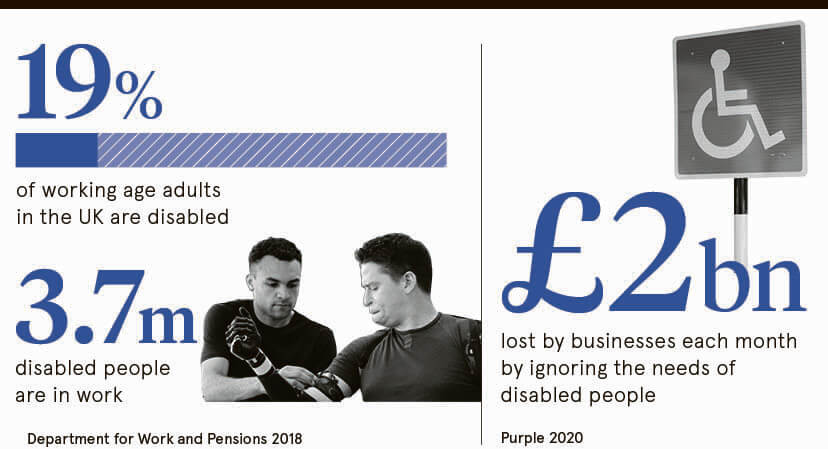It’s an interesting time to be disabled. I say this with the lived experience of someone who has been a paraplegic since 2008.
But even able-bodied onlookers can bear witness to terms like “disability inclusion” and “disability in the workplace” becoming far more prominent within business agendas, thanks in part to initiatives such as the Valuable 500. While, on the other hand, stories about disabled people encountering problems on public transport regularly appear in the mainstream press and social media.
One way or another, as we enter a new decade, disability certainly feels more visible than ever before. The question is: can society meet its requirements?
The shortcomings of the Equality Act 2010
The social model of disability is a theoretical framework which states that people are disabled by barriers in society, not by their disability. It infers that, in an ideal world, with disability inclusion at the heart of its design, a person with disability wouldn’t feel disabled because there would no longer be the environmental barriers to restrict their participation.

There is a misconception about the capabilities of disabled people, says Will Pike
To a wheelchair user, such as myself, this concept seems lofty in the extreme. I’ve lived in London for my entire life and it’s a city I call home, so I’m full of forgiveness towards its accessibility shortcomings, but there are some places that simply won’t ever be wheelchair friendly.
Mind you, that’s not an excuse, it’s simply an acceptance of reality. And herein lies the problem. The social model of disability is an ideological concept being retrofitted to an antiquated city. Like installing a hybrid engine into a steam train: the infrastructure is outdated, even if the intention is good. As such, the fact is that most disabled people will experience environmental barriers and therefore some kind of discrimination whenever they step out of the house and into society.
Frustration arises when we encounter needless barriers that stem from a lack of consideration and a “failure to make reasonable adjustments”. This is the exact terminology as found in the Equality and Human Rights Commission’s Equality Act 2010, which provides the legal framework to which businesses must comply.
However, all too often it becomes the remit of the discriminated, disabled person to flag up inadequate access and draw attention to the problem. This is embarrassing for all parties involved and could perhaps be mitigated if there was more pressure on businesses to do better.
The Valuable 500 to the rescue
This is where the Valuable 500 comes in. It’s a global diversity and disability in the workplace initiative with, in their words, “the ambitious goal of persuading 500 CEOs to make a public commitment to advance disability inclusion in their organisations”. At present, they have 250 signatories and plan to announce the final 500 at the United Nations general assembly this September.
Ambitious indeed. But the Valuable 500 isn’t just some hokey, third-sector project lacking in production values. It’s a slick, well-rounded campaign that resonates with the very brands it’s trying to entice. And the message from its founder, Caroline Casey, is clear: if you don’t include disability in your diversity agenda, you’re missing out.

The data is compelling. According to the charity Scope, there are 13.9 million disabled people in the UK, with a spending power of £249 billion. However, research done by the organisation We Are Purple suggests that high street businesses are losing up to £267 million a year due to poor disabled access, while online businesses are missing out on £11.75 billion because of inaccessible websites.
From a business perspective, it’s easy to see how these numbers become a tempting carrot for the Valuable 500 to dangle in front of hesitant chief executives. The less palatable carrot is a reminder that only 4 per cent of businesses surveyed are actually promoting disability in the workplace and striving to be more inclusive.
But what does “inclusive” really mean? What happens if, say, the Valuable 500 acquires its 500 chief executives’ signatures? How will this make the lives of disabled people better? The answer is not straightforward. Rather, it alludes to a much wider, systemic culture of discrimination that is rooted in a negative perception of disability and the capabilities of disabled people.
That aside, a commitment to disability inclusion is a concerted effort to make the physical and digital worlds more accessible for all disabled people, removing barriers and promoting a culture of diversity. By targeting chief executives, the Valuable 500 is making sure that the inclusion mandate is propagated throughout the entire business, from the boardroom to the shop floor.
Making disability in the workplace a reality
Manifestation of this cultural shift represents the start of a long journey. As indicated, barriers exist in both the physical and digital domains. But they also exist metaphysically in the form of ignorance and prejudice.
In some ways, disability activists can draw strength from recent recruitment progress made by BAME and LGBTQIA+ movements. The significant point of difference is that to accommodate disability in the workplace, businesses need to make actual changes to their infrastructure and environment; it’s not just about shifting the mindset.
This leads many businesses into uncharted waters; whether they sink or swim depends on their willingness to learn and invest. The first thing to do is simply to listen to those with experience. Speak to disability consultants and perform an accessibility audit so that you understand exactly where the problems reside. Then appoint a board-level champion who is responsible for putting in place the necessary changes and driving forward the inclusion strategy.
Lastly, try not to put too much emphasis on the fiscal benefits and remember that this is, above all, a human rights issue designed to promote disability and equality in the workplace.
The shortcomings of the Equality Act 2010

The Valuable 500 to the rescue

